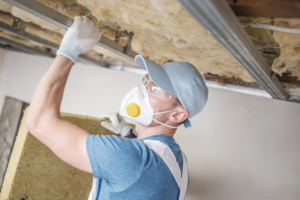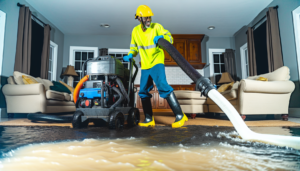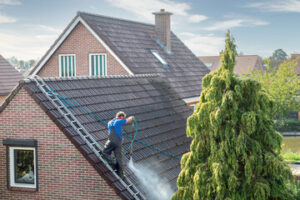Roofing Company Helena MT specializes in roofs and other exterior components of people’s homes. They employ licensed professionals and typically offer substantial warranties on their work.

They may install insulation to help homeowners save on energy costs and make their homes more resistant to storm damage. They also handle insurance claims and do inspections for real estate companies.
A roofing company’s reputation is an important factor in their success. It builds trust, enhances credibility and increases search visibility. It is also an excellent way to attract new customers and promote referrals. However, it can be difficult to manage a roofing company’s reputation. It is vital to be transparent and honest in all interactions with customers. In addition, it is important to follow best practices in managing customer reviews.
Reputable roofing companies understand the importance of customer satisfaction and maintain a high level of service. They are licensed, insured, and offer warranties on their work. In addition, they comply with local regulations and adhere to industry standards. These factors help to build customer confidence and protect homeowners from scams.
When choosing a roofing company, look for a website with testimonials and reviews from past clients. You can also check the contractor’s local presence by visiting their office or asking for references. Ideally, you should find a company that specializes in roof repair or replacement and offers other exterior services. Moreover, they should have a strong standing with manufacturers to provide significant warranties.
While it is hard to judge the quality of a roofing company’s work in photos, you can tell if the roofing company is trustworthy by looking at its reviews. A reputable roofing company will have a large number of positive reviews, as well as a detailed description of the work performed. They will also address any negative feedback professionally.
A good roofing company will have an established local presence in the community and will be recognized by local authorities, subcontractors and suppliers. They will also have a business listing on Google, which will allow them to be found by potential customers. In addition, they will have well-signed vehicles with their name, phone number and website displayed on them.
One of the most effective ways to boost your roofing business’s reputation is to request a review from each customer. This is a simple way to encourage more positive online reviews, and it can be especially effective if you include this request in your invoice or receipt. This will make it easier for your customers to remember and take the time to leave a review, and will also show your commitment to customer satisfaction.
Experience
A roofing company’s profitability is dependent on the quality of its work, and the ability to compete with other local businesses. Those who want to start their own roofing business should plan their finances carefully and involve a knowledgeable accountant from day one. Direct costs such as materials and labor can be easy to calculate, but soft costs like administrative and marketing expenses must also be considered.
Roofing companies that serve areas with high winds should be aware of the possibility of damage to roofs and take steps to mitigate this risk. For example, they may install additional fasteners or use roofing materials that are designed to withstand high winds. Moreover, they should educate homeowners on the importance of regular inspections and maintenance to ensure that their roofs are in good condition.
Roofing contractors can attract customers by advertising their services on review websites and door-to-door canvassing. They can also make their vehicles into billboards by using truck wraps to display their name, phone number and website address. Those who specialize in working with insurance claims can expect gross margins of up to 45% on residential roofing. This is a lucrative market, but only those who can navigate the complicated insurance claims process will succeed.
License
When you hire a roofing contractor, be sure to check their license and insurance. A license is an indication that the roofer has passed state-level exams and has qualified for work in your area. Typically, a licensed roofer will also be insured against liability and workers’ compensation claims.
Licensing requirements vary from state to state. Some states require roofers to have a general construction contractor’s license, while others may have their own licensing requirements for roofing contractors. In some states, you may need to pass an exam and provide proof of liability insurance before you can get a roofing contractor’s license. Other states may require roofing contractors to have a separate commercial general contractor’s license and to carry specialized liability insurance for roofers.
If you’re a roofer in New York, for example, you must have a residential roofing license to perform work on houses. However, the requirements for a residential roofing license vary by county. In fact, Queens and Bronx counties have different requirements for a residential roofing license. You can find out more about these requirements by contacting your local licensing board or visiting the website of the Department of City Business Services.
Depending on your location, you may also need a local permit to operate your roofing company. The requirements vary by state and municipality, but some states require that roofers obtain a building permit before starting any work on a home. Usually, you’ll need to submit a completed application form, an electrical and plumbing plan, and proof of liability insurance.
There are many ways to advertise your roofing business, including door-to-door canvassing and newspaper ads. You can also use a Google listing and truck wraps to promote your business. These advertising tools will help you reach potential customers and increase your sales.
Roofing contractors can also reduce the risk of wind damage by using materials that are more resilient to high winds. In addition, they can educate homeowners on how to prevent damage from high winds and advise them of storm preparation plans. They can also recommend a wind inspection and make necessary repairs before high winds occur.
Insurance
Roofing is a dangerous occupation, and workers can sustain injuries even when following safety procedures. Consequently, it’s best for roofing companies to have workers’ compensation insurance. This type of coverage pays for medical treatment, lost wages, and legal fees. Moreover, it safeguards your business by preventing lawsuits. In addition, you should have commercial auto insurance in place to cover the cost of any vehicles that are used for work.
General liability insurance is another vital coverage for roofing contractors. It protects your business from claims that result from property damage, bodily injury or advertising injury. It can also cover the cost of repairs or replacement for your company’s property, such as tools and equipment. This policy can be purchased as a stand-alone product or included in a comprehensive business owner’s policy package.
You can also have errors and omissions coverage, which will pay for your legal costs if a client sues you because of a mistake you made in your work. This policy can protect your business from costly legal fees if you are accused of false advertising, libel or slander, copyright infringement, and more.
Finally, you can purchase tool and equipment coverage to protect your investment in roofing materials. This coverage can reimburse you if your tools and equipment are stolen or damaged while on the job. You can also buy umbrella insurance, which provides additional coverage beyond your existing policies.
Several factors impact the price of roofing insurance, including the amount of coverage you want and your previous business claims history. You should review these details with your insurance agent to ensure that you have enough coverage to handle all possible risks. Ideally, your insurance should cover the cost of all the worst-case scenarios that could happen to your business. For instance, a lawsuit or an incident could cost millions of dollars in damages, so it’s important to have sufficient coverage. Moreover, you should purchase a policy with flexible terms and limits to fit your business’s needs. Additionally, make sure you have a deductible, which is the amount you’ll pay out-of-pocket before your insurer takes over costs.








